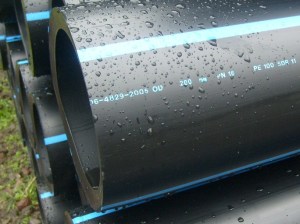High-Density Polyethylene Pipe (HDPE or PE Pipe) is
made from ethylene, which can be derived from either crude oil or
natural gas. PE pipe is extremely strong, durable, flexible, corrosion
free and chemical resistant. These features make it perfect for a
variety of underground conditions and help it last up to 100 years. The
smooth walls allow for less friction, which increase flow through the
same diameter as that of other pipes.
When installed, the pipe is joined by a heat fusion process, which
prevents leakage. By using PE pipe, municipalities save a vast amount of
water and reduce repair rates. This translates into a significant cost
savings for the life of the pipe. PE pipe can carry potable water,
wastewater, chemicals, hazardous wastes and compressed gases. PE is the
preferred piping material for natural gas distribution because there is
no tolerance for leaks and no worries about corrosion.
PE pipe and Chili's earthquake
This subduction zone earthquake seriously impacted the City of Concepcion, with a population over 1,300,000 people. The water system in this city had not been designed for earthquakes. Strong ground shaking and liquefaction damaged the city's only water treatment plant. Liquefaction damaged many of the larger diameter steel transmission pipelines. Liquefaction damaged many distribution water pipelines (about 3,000 total).
Water outages to customers were lengthy, over a month to some customers. Even so, there was some good news: Essbio (the water system operator) had been installing HDPE pipe in its water distribution system for about a decade prior to the earthquake; while the rest of the water system suffered thousands of damaged pipes, no HDPE pipe was damaged.
This earthquake also shook a wide area of Chile, much of it rural/farming. Over the prior decade, the central government of Chile had installed 2,000 small wells – water tank systems for these small farming communities (typical population of 100 people or fewer). A standardized type elevated steel tank design was used throughout the country.
Unfortunately, the design was insufficient for strong ground shaking, and at least 73 of these elevated steel tanks collapsed, sometimes causing fatalities. The restoration of water service after the earthquake was seriously slowed down by the failure of the regional power supply and communication networks (cell phones).
The water companies had learned to use cell phones as their primary method for voice communication. Primarily because of the failure of the widespread cell phone system, restoration efforts were delayed by a few days.
There were two fire ignitions requiring fire department response after the earthquake; there was no fire spread. The damage to the water system had no impact on the outcomes of these fires.
Conclusion: Better using PE pipe compare to others.
#jualpipahdpe
#kontraktorpipahdpe
#jualcompressionfitting
#jualbuttfusionfitting
#jualmesinbuttfusion
#sewamesinlashdpe
#jualgeomembranehdpe
#jualsegmentedfittinghdpe













.JPG)







